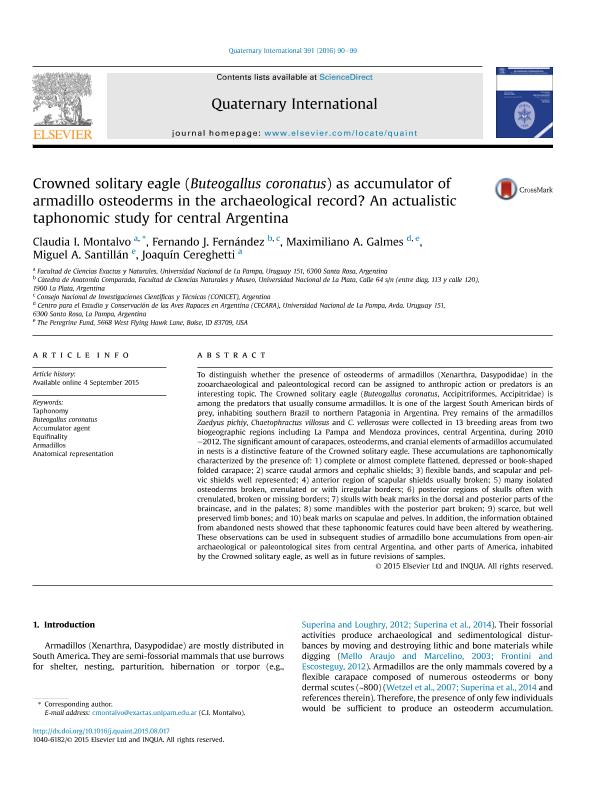Artículo
Crowned solitary eagle (Buteogallus coronatus) as accumulator of armadillo osteoderms in the archaeological record? An actualistic taphonomic study for central Argentina
Montalvo, Claudia Inés; Fernández, Fernando Julián ; Galmes, Maximiliano Adrian; Santillán, Miguel Ángel; Cereghetti, Joaquín
; Galmes, Maximiliano Adrian; Santillán, Miguel Ángel; Cereghetti, Joaquín
 ; Galmes, Maximiliano Adrian; Santillán, Miguel Ángel; Cereghetti, Joaquín
; Galmes, Maximiliano Adrian; Santillán, Miguel Ángel; Cereghetti, Joaquín
Fecha de publicación:
01/2016
Editorial:
Pergamon-Elsevier Science Ltd
Revista:
Quaternary International
ISSN:
1040-6182
Idioma:
Inglés
Tipo de recurso:
Artículo publicado
Clasificación temática:
Resumen
To distinguish whether the presence of osteoderms of armadillos (Xenarthra, Dasypodidae) in the zooarchaeological and paleontological record can be assigned to anthropic action or predators is an interesting topic. The Crowned solitary eagle (Buteogallus coronatus, Accipitriformes, Accipitridae) is among the predators that usually consume armadillos. It is one of the largest South American birds of prey, inhabiting southern Brazil to northern Patagonia in Argentina. Prey remains of the armadillos Zaedyus pichiy, Chaetophractus villosus and C. vellerosus were collected in 13 breeding areas from two biogeographic regions including La Pampa and Mendoza provinces, central Argentina, during 2010-2012. The significant amount of carapaces, osteoderms, and cranial elements of armadillos accumulated in nests is a distinctive feature of the Crowned solitary eagle. These accumulations are taphonomically characterized by the presence of: 1) complete or almost complete flattened, depressed or book-shaped folded carapace; 2) scarce caudal armors and cephalic shields; 3) flexible bands, and scapular and pelvic shields well represented; 4) anterior region of scapular shields usually broken; 5) many isolated osteoderms broken, crenulated or with irregular borders; 6) posterior regions of skulls often with crenulated, broken or missing borders; 7) skulls with beak marks in the dorsal and posterior parts of the braincase, and in the palates; 8) some mandibles with the posterior part broken; 9) scarce, but well preserved limb bones; and 10) beak marks on scapulae and pelves. In addition, the information obtained from abandoned nests showed that these taphonomic features could have been altered by weathering. These observations can be used in subsequent studies of armadillo bone accumulations from open-air archaeological or paleontological sites from central Argentina, and other parts of America, inhabited by the Crowned solitary eagle, as well as in future revisions of samples.
Archivos asociados
Licencia
Identificadores
Colecciones
Articulos(CCT - LA PLATA)
Articulos de CTRO.CIENTIFICO TECNOL.CONICET - LA PLATA
Articulos de CTRO.CIENTIFICO TECNOL.CONICET - LA PLATA
Citación
Montalvo, Claudia Inés; Fernández, Fernando Julián; Galmes, Maximiliano Adrian; Santillán, Miguel Ángel; Cereghetti, Joaquín; Crowned solitary eagle (Buteogallus coronatus) as accumulator of armadillo osteoderms in the archaeological record? An actualistic taphonomic study for central Argentina; Pergamon-Elsevier Science Ltd; Quaternary International; 391; 1-2016; 90-99
Compartir
Altmétricas



